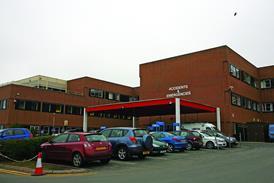The drive for recovery in the health service requires the whole system to flow and this kind of change takes time
I was in Manchester last weekend and drove back on the M6. As we approached the Cheshire/Staffordshire border the traffic slowed down and stopped. We then crawled slowly for what seemed like ages and then near to the Stafford exit there it was, an insignificant little car being loaded onto the back of a recovery vehicle.
“Was that all it was?” was the cry from my 10-year-old. And, of course, that’s all it was.
‘Like the motorway, the solution can be quite simple, but it is often not where it first appears to be’
While it is tempting to just blame the sheer weight of traffic, often it is something simple downstream that holds everything up, increases the risk of more accidents and makes everyone stressed. We know all about queues in the NHS.
Our trust has suffered more than most in the past and as a consequence we volunteered for the Health Foundation’s Flow Cost Quality project. I won’t go over all of the learning but I was asked to provide an update and a reflection, now 18 months on from when we implemented some of the most significant changes.
- Single trust responsible for over half of national 12 hour waits
- A&E performance at all-time low as emergency admissions peak
Know your systems
Remarkably, things are all still going well in our system, but part of the reason for that is that we haven’t rested on our laurels.
One of the key learning points from the project was that you have to know your systems and all of the solutions in the world won’t help you if you don’t have the right capacity. So we keep changing as the environment does.
In terms of key performance indicators, we have moved from one of the worst performers on the four hour target to one of the best. We have met the target in all but two months since summer 2013 and are still managing to hold above 95 per cent this year despite the system-wide pressure.
‘Our clinicians are doing what they trained to do, and liking it”
Our mortality has moved from above average to below average.
The newly published A&E patient survey has moved us from average to being in the top 10 “most liked” and our clinicians are doing what they trained to do, and liking it.
We have just looked back on our capacity plans from three years ago and realised that we have more activity but with the equivalent of 40 less beds.
As a consequence we are still delivering a small surplus even though we have seen no rebasing of our emergency tariff and hence get paid less than most trusts for the work.
So it is all quite remarkable, really. Whenever I am asked to talk about what we did I try to emphasise a few key messages.
Key messages
First, this kind of whole system change takes time. You need to understand your system and solve the blockages in it with the right solutions, in the right volume and they take time to bed in. Like the motorway, the solution can be quite simple, but it is often not where it first appears to be.
Second, you need to co-produce solutions with clinicians who bring ideas and enthusiasm to implement.
Third, it is a continuous challenge; you need to make sure that every part of the system understands their demand and their capacity and that they routinely monitor it – they will always find that the demand is much less variable than the capacity.
‘Don’t blame someone else or use the “sheer weight of traffic” argument’
We, of course, have bad days, like all systems do. Bad days in the NHS cause queues, not quite stretching from one county to another like the M6. However, sometimes it feels like it.
But the headroom from the good days means that you don’t panic. When the system gets blocked we now look internally for an explanation - a problem with medical cover on a ward, a slow down in a diagnostic department - rather than either blaming someone else or using the “sheer weight of traffic” argument.
However, most importantly, we have learned that the whole system needs to flow. We run hospital and community services and it was the hard work of our community staff, the way they became more responsive, which was the final piece of a complicated jigsaw.
A&E target matters
The other message from me, I know, some people won’t like: some people feel that the A&E target is divisive. But I really do think that it matters. We know that it is more of a measure of flow in the whole system than simply a measure of how well A&E is performing.
We have also proven that patient experience, and more crucially patient safety, is compromised when the four hour target isn’t being met. So I would urge this not to be dismissed.
‘I have sympathy for those under intense scrutiny as it can be debilitating’
Of course, the reason why some people don’t like the target is that it has become a stick to beat people with and has created a focus on explaining yesterday’s performance rather than spending time getting things right for the future.
So I do have tremendous sympathy for those under intense scrutiny on this as it can be debilitating.
Conference calls and escalation meetings don’t solve flow problems. Someone has to have the time to look ahead, solve the problem and drive that recovery vehicle down the hard shoulder.
Glen Burley is chief executive of South Warwickshire Foundation Trust


























6 Readers' comments